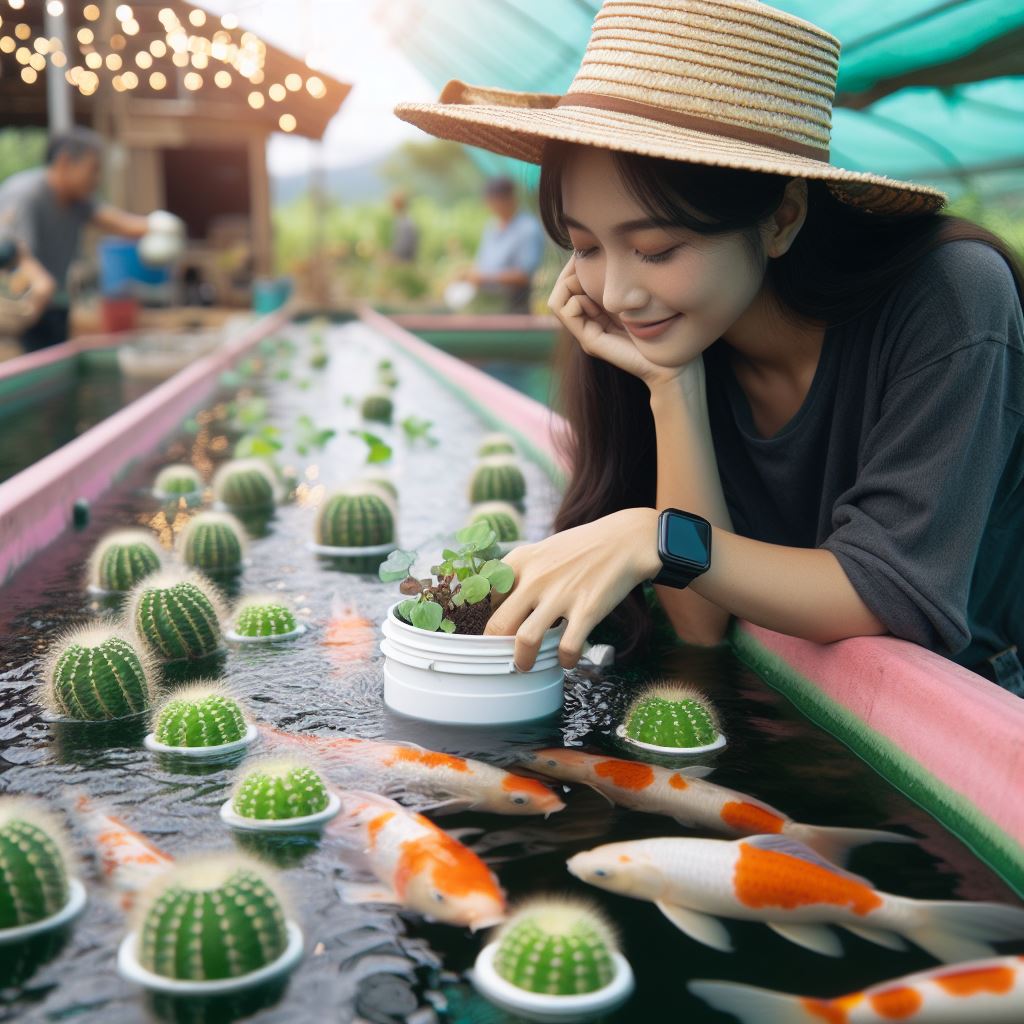Introduction
Aquaponics is a sustainable farming system that combines aquaculture and hydroponics in a symbiotic environment.
In aquaponics, fish waste provides nutrients for plants, while plants filter and purify the water for the fish.
This closed-loop system has numerous benefits, including water conservation, reduced chemical inputs, and increased crop yields.
Aquaponics has great potential in small-scale farming, as it allows individuals to grow both fish and vegetables in limited spaces.
By utilizing vertical farming techniques, aquaponics systems can maximize production while minimizing land use.
Furthermore, aquaponics can be implemented in urban areas, promoting local food production and reducing transportation costs.
In addition, the system requires less water compared to traditional farming methods, making it more environmentally-friendly.
Aquaponics also promotes organic farming practices, as it eliminates the need for synthetic fertilizers and pesticides.
Moreover, this innovative farming method allows for year-round production, providing a consistent food supply.
Overall, aquaponics has the potential to revolutionize small-scale farming by offering a sustainable and efficient farming system.
Benefits of Aquaponics for Small Scale Farming
Aquaponics is a sustainable farming method that combines aquaculture and hydroponics in a symbiotic system.
The benefits of aquaponics in small-scale farming are numerous.
Firstly, one of the major advantages is the efficient use of space.
The aquaponic system can be set up vertically, allowing farmers to grow more produce in a limited area.
By stacking plant beds above fish tanks, the space is maximized, making it ideal for small-scale farming.
Conserves water
Furthermore, aquaponics conserves water compared to traditional farming methods.
The closed-loop system recycles water, reducing the amount needed for irrigation.
This is crucial in regions facing water scarcity or drought conditions.
Reduces the need for chemical fertilizers
Additionally, aquaponics reduces the need for chemical fertilizers.
The fish waste provides essential nutrients for plant growth, eliminating the reliance on synthetic fertilizers.
This not only saves money but also promotes organic farming practices.
Provides a sustainable source of food
Aquaponics stands as a beacon of sustainability in modern farming, offering a harmonious ecosystem where plants and fish thrive symbiotically.
This innovative system not only provides a consistent source of food but also mitigates the environmental impact associated with traditional farming practices.
Operating self-sufficiently year-round, regardless of external factors like season or climate, aquaponics ensures a steady supply of fresh produce and fish.
By eliminating the reliance on external factors, it offers farmers a reliable means of food production.
The controlled environment of aquaponics not only fosters optimal growth conditions for plants but also shields them from pests and diseases.
This translates to healthier crops without the need for chemical interventions.
Furthermore, the fish raised in aquaponic systems are free from contaminants, offering a safe and nutritious source of protein.
Transform Your Agribusiness
Unlock your farm's potential with expert advice tailored to your needs. Get actionable steps that drive real results.
Get StartedOne of the most significant environmental benefits of aquaponics is its reduction of water pollution.
The system filters fish waste through the plant beds, preventing harmful chemicals from entering water bodies and preserving aquatic ecosystems.
Additionally, aquaponics minimizes soil erosion since plants grow without soil, thus reducing the carbon footprint associated with traditional farming methods.
Moreover, aquaponics enhances biodiversity by creating a habitat for various organisms.
The fish tanks and plant beds attract beneficial insects, promoting natural pest control and contributing to a balanced ecosystem.
Not only does aquaponics offer environmental benefits, but it also presents a lucrative opportunity for small-scale farmers.
With the rising demand for fresh, locally-grown produce and fish, aquaponics provides a profitable avenue for farmers to meet consumer needs while reducing labor requirements through automation potential.
In essence, aquaponics embodies the principles of sustainability, offering a viable solution for food production that is efficient, environmentally friendly, and economically viable for small-scale farmers.
Types of Aquaponics Systems suitable for Small Scale Farming
Aquaponics is a sustainable farming method that combines aquaculture and hydroponics.
It is gaining popularity worldwide, especially for small-scale farming.
There are various types of aquaponics systems that are suitable for small-scale farming.
Each of these aquaponics systems has its advantages and considerations for small-scale farming.
Nutrient Film Technique (NFT)
NFT, with its shallow channels, requires less water compared to other systems.
This makes it suitable for areas with limited water supply or for water-conscious farmers.
Additionally, NFT allows for easy monitoring of nutrient levels and provides good aeration for the plants’ roots.
Deep Water Culture (DWC)
DWC, on the other hand, offers excellent support and nutrient availability for larger plants.
It is relatively simple to set up and maintain, making it a popular choice for beginners in aquaponics.
However, DWC requires more water than NFT, and proper aeration is crucial to prevent oxygen depletion.
Media-based bed systems
Media-based bed systems provide a stable growing environment for plants.
The media acts as a filtration system, removing excess solids and improving water quality for the fish.
This system allows for greater plant diversity and can support a larger biomass of fish.
However, media-based bed systems may require periodic cleaning and maintenance to prevent clogging.
When setting up an aquaponics system for small-scale farming, several factors should be considered.
These include the available space, climate conditions, budget, and desired crops.
It is essential to choose a system that aligns with these factors and meets the specific needs of the farmer.
Furthermore, integrating aquaponics with renewable energy sources such as solar power can further enhance sustainability and reduce operational costs for small-scale farmers.
The combination of aquaponics and renewable energy promotes self-sufficiency and reduces reliance on traditional farming methods.
In fact, aquaponics offers a viable solution for small-scale farming.
The Nutrient Film Technique, Deep Water Culture, and media-based bed systems are all suitable options depending on specific requirements.
By embracing aquaponics and choosing the right system, small-scale farmers can grow a variety of crops sustainably while conserving resources and minimizing environmental impact.
Read: Next-Gen Farmers: Shaping Agriculture’s Future
Setting Up an Aquaponics System for Small Scale Farming
Aquaponics is an innovative and sustainable farming practice that combines aquaculture and hydroponics.
It provides a unique opportunity for small-scale farmers to grow fish and plants in a symbiotic environment.
To set up an aquaponics system, there are several key factors to consider.
Choosing the Location
- Find a suitable location that receives ample sunlight for plant growth.
- Ensure the area is easily accessible for maintenance and harvesting purposes.
- Consider proximity to a water source to minimize transportation requirements.
- Assess the availability of electricity for operating pumps and other equipment.
Required Equipment and Materials
- Fish tank: Select a tank size appropriate for your space and desired fish species.
- Grow beds: Use containers or build raised beds to grow plants hydroponically.
- Water pump: Install a reliable pump to circulate water between the fish tank and grow beds.
- Aeration system: Maintain dissolved oxygen levels in the water for fish health and plant growth.
- Filtration system: Incorporate mechanical and biological filters to remove waste and maintain water quality.
- pH and temperature monitoring equipment: Regularly monitor and adjust these factors for optimal growth.
Importance of Water Quality
- Water quality is crucial as it directly impacts the health of both fish and plants.
- Maintain appropriate pH levels (around 6.8) to ensure nutrients are available to plants.
- Monitor ammonia and nitrate levels to prevent water toxicity and fish stress.
- Regularly test water for temperature, dissolved oxygen, and alkalinity for optimal conditions.
- Use dechlorinated water or install a chlorine removal system to remove harmful chemicals.
Selection of Fish and Plants
- Choose fish species that can thrive in a closed aquaponics system, such as tilapia or trout.
- Consider local regulations and availability when selecting fish species for farming.
- Select plants that can grow hydroponically, such as lettuce, kale, or herbs.
- Ensure that the selected plants have similar water and nutrient requirements to the chosen fish species.
- Aim for a balanced ecosystem where fish waste provides nutrients for plant growth, while plants filter and oxygenate the water for fish.
In short, setting up an aquaponics system for small-scale farming requires careful consideration of the location, equipment, water quality, fish, and plant selection.
By creating an optimal environment, farmers can enjoy a sustainable and productive system that maximizes the use of space and resources.
Read: Vineyard Dreams: Sustainable Wine Making

Delve into the Subject: Heritage Crops: A Farmer’s Preservation
Maintaining an Aquaponics System in Small Scale Farming
Aquaponics is an innovative and sustainable farming method that combines aquaculture and hydroponics.
It is a closed-loop system that allows for the growth of both fish and plants in a symbiotic relationship.
However, like any farming system, it requires proper maintenance to ensure its success.
Here are some key tasks involved in maintaining an aquaponics system in small scale farming:
Monitoring water quality parameters
- Regularly test the pH level of the water to ensure it remains within the optimal range for fish and plant growth.
- Monitor the levels of ammonia, nitrite, and nitrate to prevent any toxic buildup that could harm the fish or plants.
- Keep an eye on the oxygen levels in the water to ensure adequate oxygenation for the fish.
Feeding and caring for fish
- Provide the fish with a nutritionally balanced diet suitable for their species and growth stage.
- Feed the fish in appropriate quantities and frequency to prevent overfeeding and the accumulation of uneaten food.
- Monitor the health of the fish, looking out for any signs of disease or stress.
Managing plant growth
- Regularly prune and harvest plants to maintain proper spacing and prevent overcrowding.
- Monitor the nutrient levels in the water and adjust accordingly to meet the plants’ nutritional needs.
- Provide adequate lighting for the plants to promote photosynthesis and healthy growth.
Preventing and dealing with common pests and diseases
- Implement preventive measures such as regularly cleaning and disinfecting the system to reduce the risk of disease.
- Introduce beneficial insects or biological controls to manage pests without the need for harmful chemicals.
- Monitor the plants for signs of pests or diseases and take appropriate action to mitigate the issue.
In addition to these tasks, it is also crucial to maintain good records and track the performance of the aquaponics system over time.
This includes documenting water quality measurements, fish growth rates, plant yields, and any issues encountered.
By keeping track of this information, farmers can identify trends, make informed decisions, and continuously improve the system’s performance.
To effectively maintain an aquaponics system, it is essential to remain vigilant, observant, and proactive.
Regular monitoring of water quality parameters, attention to fish care, active management of plant growth, and taking preventative measures against pests and diseases are all critical aspects of successful aquaponics farming.
By dedicating time and effort to maintaining the system, small scale aquaponics farmers can enjoy a productive and sustainable farming endeavor.
From providing fresh produce to growing fish, aquaponics offers numerous benefits while minimizing the environmental impact typically associated with traditional farming methods.
So, whether you are a hobbyist or a commercial farmer, investing in the maintenance of your aquaponics system will undoubtedly yield rewarding results.
Read: Alaskan Farmers’ Quest for Eco Balance
Successful Examples of Aquaponics in Small Scale Farming
Urban rooftop aquaponics farm
In a bustling city, a rooftop aquaponics farm has proven to be a successful venture.
The farm utilizes the space on top of a building to grow both fish and plants.
With careful planning and efficient design, this urban farm produces an abundance of fresh, organic produce.
The aquaponics system recirculates water, providing nutrients to the plants and creating a sustainable environment for the fish.
This innovative approach to farming is not only profitable but also helps raise awareness about sustainable agriculture in urban areas.
Community aquaponics project in a residential area
In a residential area, a community has come together to create an aquaponics project.
By utilizing unused backyard spaces, the residents have built a small-scale farm that benefits everyone involved.
The project not only provides fresh produce but also fosters a sense of community among the participants.
Residents contribute their time and resources, creating a sustainable and supportive network.
The success of this community aquaponics project showcases the potential for self-sufficiency and promotes cooperation among neighbors.
Showcase Your Farming Business
Publish your professional farming services profile on our blog for a one-time fee of $200 and reach a dedicated audience of farmers and agribusiness owners.
Publish Your ProfileRead: Urban Farmer Shift to Sustainable Methods
Lessons learned and key takeaways
Through these successful examples, several lessons can be learned for implementing aquaponics in small-scale farming:
- Aquaponics can be adapted to various environments, including urban areas and residential spaces.
- Efficient space utilization and design are crucial for maximizing productivity.
- Recirculating water systems promote sustainability and reduce water waste.
- Community involvement and cooperation are essential for the success of small-scale aquaponics projects.
- Aquaponics provides a viable solution for producing fresh, organic produce locally.
- These success stories inspire and motivate others to explore aquaponics as a sustainable farming method.
- With proper planning and education, aquaponics can be a profitable and environmentally friendly farming option.
In general, aquaponics has proven to be a successful method for small-scale farming in various settings.
Whether it’s an urban rooftop farm or a community project in a residential area, aquaponics offers numerous benefits.
Lessons learned from these examples highlight the importance of efficient design, community involvement, and sustainability.
By embracing this innovative farming technique, individuals and communities can contribute to local food production and environmental conservation.
Aquaponics truly puts farming in action, showing the potential for a greener and more self-sufficient future.
Conclusion
Aquaponics offers numerous benefits and potential for small-scale farming.
By combining aquaculture and hydroponics, this innovative farming method allows for efficient use of resources, higher crop yields, and sustainable food production.
Aquaponics eliminates the need for synthetic fertilizers and pesticides, making it an environmentally friendly option.
It also conserves water, as it uses 90% less water than traditional farming methods.
Furthermore, aquaponics creates a symbiotic relationship between fish and plants, where fish waste provides essential nutrients for plant growth, and the plants filter the water, creating a clean and healthy environment for the fish.
The potential of aquaponics is vast, as it can be implemented in various settings, including urban areas and areas with limited access to fertile land.
It allows individuals to grow their own food and become more self-sufficient.
By adopting aquaponics, farmers can diversify their income streams by selling both fish and produce.
This not only provides economic benefits but also contributes to food security in communities.
We encourage readers to explore aquaponics and consider its adoption in their own farming ventures.
With proper knowledge and guidance, aquaponics has the potential to revolutionize the way we farm, bringing us closer to sustainable and resilient agriculture systems.
So, why not take a step towards a more sustainable future and try aquaponics in your own farm?
Start small, learn, and embrace the benefits it offers for you, your community, and the planet.




